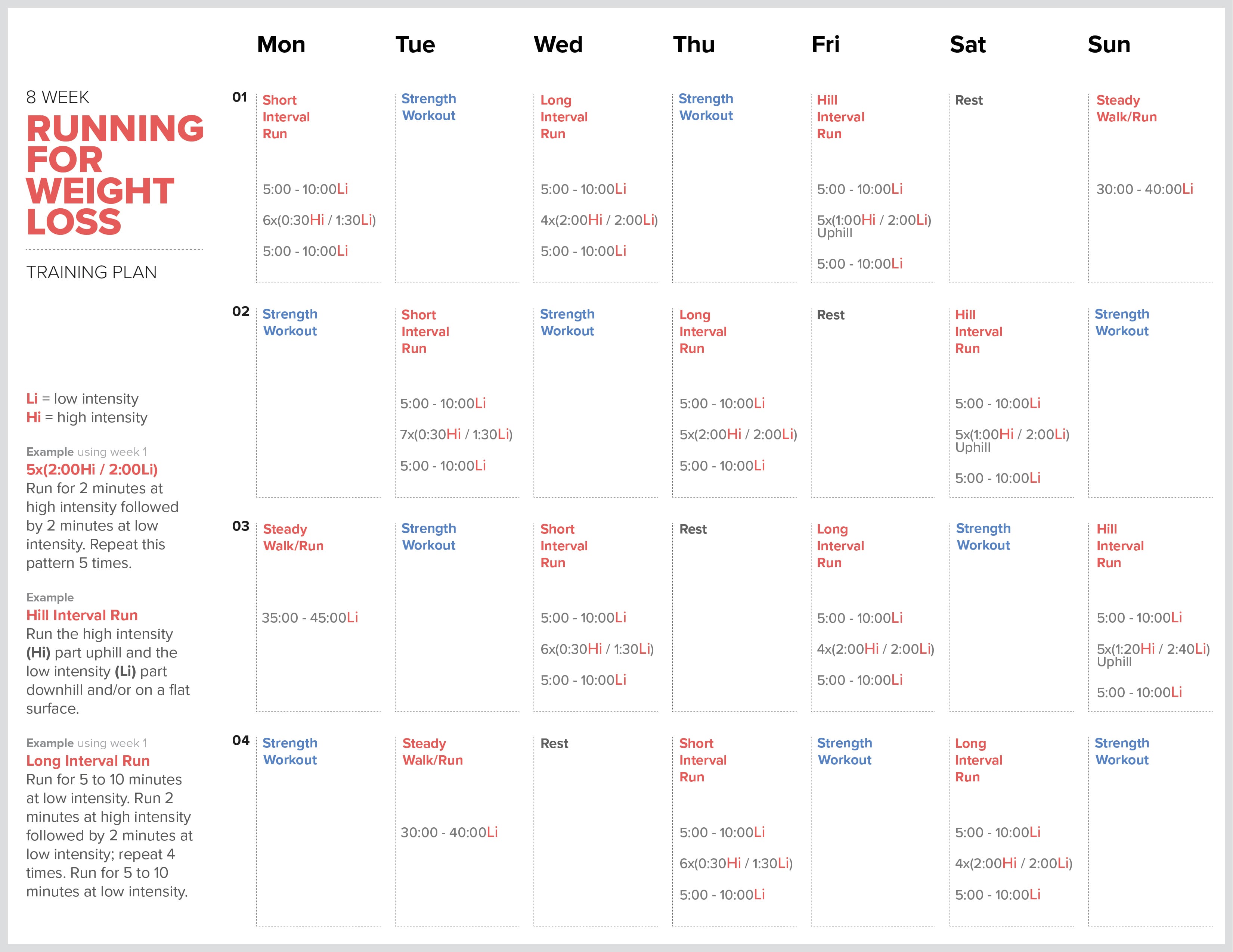8 Week Running for Weight-Loss Program

Running can be an effective weight-loss tool if you take the right approach to it. Our 8-Week Running for Weight-Loss Program combines three key elements that are proven to yield the best results: high-intensity aerobic exercise, strength training, and a healthy, portion-controlled diet.
How to Lose Weight Running
It’s important to keep in mind that your goal shouldn’t be just to lose weight… but more specifically, to lose fat.
Running can help you burn body fat, in combo with diet (as mentioned earlier), because it’s one of the highest calorie burners when it comes to working out.
Running requires a ton of muscle power and energy to continually move and propel your body forward, mile after mile.
But it’s important to remember that losing weight really boils down to calories in and calories out. You may still lose weight with running alone but honing in on your diet can help excel your efforts.
A recent study following more than 500 novice runners for one year found that runners clocking in more than three miles per week lost about four pounds, just from running alone.
But the running group who also covered more than three miles per week, but also made tweaks to their diet, lost 12.3 pounds on average over the course of a year.
Running Schedule for Weight Loss


Weight-Loss Running Plan Overview
Our program employs a simple, two-zone intensity system:
- Low intensity (Li): This is a pace at which you can talk comfortably, but beyond which speaking in full sentences will become difficult. If you train by heart rate, Li translates to 70 to 75 percent of maximum heart rate. Note that, if your current fitness level is low, you may need to walk initially to stay at low intensity.
- High intensity (Hi): This is defined by the specific structure of each workout. Whether you’re doing short intervals, long intervals, or hill repetitions, aim to complete the full session at the highest speed you can sustain for every interval or repetition without slowing down.
This means you will run shorter intervals a little faster than longer intervals. It may take a little practice to master your pacing in each workout type; that’s OK. Just keep in mind it’s better to start out a little too conservatively and finish with something left in the tank than to start out too aggressively and hit the wall.
The schedule includes both beginner and intermediate options. Here are some tips on how to adapt it for you and your fitness level:
- If you haven’t exercised much lately, select the shorter options for warm-ups and cooldowns (e.g., go with 5 minutes where you see “5:00–10:00″). Do the same for steady walks/runs, and do your low-intensity efforts at a walk if necessary.
- If you’re in pretty good shape but new to running, select the longer options for warm-ups, cooldowns, and steady walks/runs, and jog your low-intensity efforts if you can do so while catching your breath and recovering enough before your next interval (if you can’t, walk these).
- The interval blocks are structurally the same for everyone. If you see this, “6x(0:30Hi/1:30Li),” it means you sprint for 30 seconds at high intensity, with a minute and a half of jogging or walking after each sprint, and complete this sequence six times total.
- Naturally, the fitter you are, the faster your sprints will be, and that’s what makes the interval blocks one-size-fits-all. Try to run all your intervals on flat, smooth terrain. The optimal slope for hill repetitions is a moderate six to eight percent.
- Finally, note that Week 4 and Week 8 are lower-volume weeks. Your training load is slightly reduced (rather than increased) from the previous week to give your body a chance to recover. That will help prevent overtraining and help optimize performance and goal progress. Enjoy!
The Best Type of Running for Weight Loss
Calculating calorie burn for an activity like running is more complex than it might seem. Although the American Council of Exercise offers recommendations of the approximate caloric cost of running per minute based on speed, keep in mind that your calorie burn may differ depending on your age, body weight, and general activity level.
Also, the more weight you lose, the fewer calories your body burns at rest, so your initial estimate of how much you need to run for weight loss may change over time. A better strategy is to set a weight-loss goal and combine running and strength training completed by diet changes. What’s the best type of running for weight loss? The program that makes you want to keep going. So, lace up and get started.
High-Intensity Running Workouts for Weight Loss
Studies show that shorter workouts at a moderate to high intensity are just as effective for weight loss as those longer, slower runs. Adding in these high-intensity interval training (HIIT) runs offers variety to your running program, and they save you time on those days when your schedule might be a little more hectic.
Our program (schedule above) features an eight-day workout cycle that includes three different types of high-intensity runs and one low-intensity run/walk.
Strength Training for Runners
Adding in a couple days of strength training can pay off in spades for runners. While it likely won’t lead to more weight loss, strength training while following a running program can help you maintain or increase your lean body mass — which helps maintain your metabolism — even as you are losing weight.
There are two strength-training sessions scheduled during each eight-day cycle in our 8-Week Running for Weight-Loss Program.
By focusing on compound (multi-joint) exercises that collectively target your entire body (read: not just your legs), a heavy strength-training workout can help increase running speed, running economy, power output, and time to exhaustion, according to a review in the Scandinavian Journal of Medicine and Science in Sports.
And by doing resistance training regularly, you can cut your overall risk of injury. A recent review looked at more than 25 different studies to determine which interventions or actions we can take to help prevent sports injuries; strength training reduced sports injuries to less than ⅓ and overuse injuries were almost cut in half.
